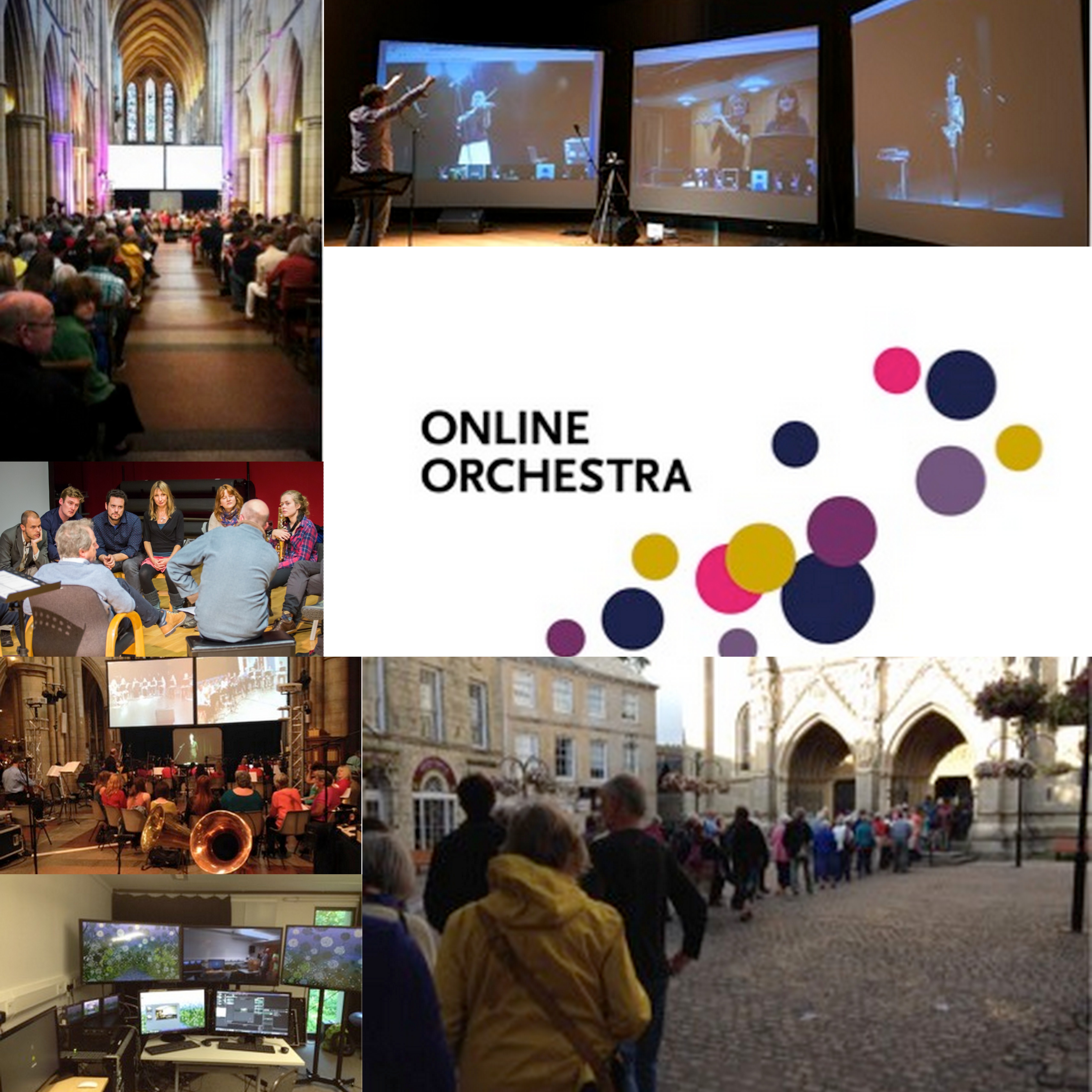Falmouth-based project that enables groups of musicians in different locations to perform together live, in real time, online, thereby creating new opportunities for ensemble performance, particularly for those living in remote locations.
What is the context of the work?
Setting
This potentially could be any setting in any location with access to a good broadband connection. In the pilot project, the four settings involved were Truro Cathedral (main strings and choir), the Scilly Isles (large flute section), Mullion, Cornwall (brass section) and Falmouth University (orchestral conductor).

Age of students
In the pilot study, participants ranged from ages 11 to 80 (see http://onlineorchestra.com/performance/ ). More significant than age is current instrumental ability, taking the standard grading system as a measure, such that members of the ensemble are well matched to the demands of the selected repertoire—as with any instrumental ensemble. Specific iterations could involve particular age groupings, such as an ensemble entirely formed of secondary school students.
Number of students
This is contingent on the music being performed. In the pilot study, c50 musicians were involved.
Does the example fit into longer-term plan, or is it 'stand-alone'?
It is the first stage of what could be a very wide-ranging longer term plan, including many different geographical locations and, in particular, distant and rural settings, as well as many different instrumental combinations, and repertoires.
Who is leading the work?
The work is being led by Professor Michael Rofe, Academy of Music & Theatre Arts, Falmouth University ( https://www.falmouth.ac.uk/content/dr-michael-rofe ).
Any other relevant information?
The first pilot stage of the project was funded by a research grant from the UK Arts and Humanities Research Council (AHRC), October 2014 to March 2016. Its success was evidenced in terms of technological innovation and expertise, positive audience reaction, and the reported building of positive attitudes and skills in the participants (see http://onlineorchestra.com/wp-content/uploads/Online-Orchestra-Project-Report.pdf ). Further funding is now being sought for the future development of the Online Orchestra.
What is the content of the work?
Young and amateur musicians living in remote locations around the UK have limited access to large-scale ensemble performance opportunities. In Five Islands School on the Isles of Scilly, for instance, children only learn woodwind instruments due to the unavailability of other specialist instrument teachers. As such, those children have no chance to play in larger orchestral ensembles without flying to the mainland. Ensemble performance is a key component of the National Plan for Music Education (NPME) in England in 2011 ( https://www.gov.uk/government/publications/the-importance-of-music-a-national-plan-for-music-education ), and is vital for the development of musical skills. The Online Orchestra seeks to connect remotely located groups of musicians together to form an online ensemble, thereby enabling similar opportunities as those available to children and amateur musicians living in urban centres.
Through extensive testing and development, the project has developed an approach to online ensemble performance that preserves many characteristics of traditional ensemble performance – scores in standard notion, a live (remotely located) conductor, and a sense of relationship between self, section (a remote location) and orchestra (the full ensemble). In order to achieve this, the project developed original software to manage network latency (normal time lag in an internet-based system for data to be transferred), and commissioned music that was specially designed for an online environment, such that real-time performance was possible.
In connecting remote communities, broader personal and social benefits are also enabled, as cohesion is created within an individual location, and as relationships are formed with other locations. Participants and audiences at all locations can see and hear one another live and in high definition, and so can interact meaningfully over the network. Online play is a crucial part of this, allowing remotely located participants to have fun online and meet new people, sharing in the single overall goal of music making.
The project represents a completely new and innovative approach to musical collaboration, which can transcend problems of geography and location. Although similar projects have been attempted in the past, this has largely used more specialised technologies such as high-speed broadband on University networks: the great strength of the current project is that it deliberately involves equipment that is readily available in schools.
What are the key features of the teaching and learning approach?
Please describe the methods used and if relevant please note any underpinning key assumptions, references or models.
The Online Orchestra project is inclusive in the sense that all participants are integral in its ultimate success, and it relies just as much on social as on musical expertise. In this sense the teaching-learning approach could be said to be student-centred and designed to facilitate peer learning and interaction.
Individual locations (nodes) each have a node-leader – a local musical expert, such as a teacher or instrument tutor – to support musicians in that location. The Online Orchestra preserves the role of the conductor as directing the overall ensemble. Inter-nodal audio-visual communication is core to the structure, allowing for the usual types of conductor-musician conversations. As such, online rehearsal is also a core part of the approach, meaning that the primary conductor does not need to be located with musicians.
In summary, traditional ensemble rehearsal and performance have been used as the model here, with the intention of preserving—as far as is possible—the approaches and techniques with which musicians will be familiar. Those features that are more complex to replicate online (such as working with screens showing two-dimensional images of a conductor and other nodes) were trialled during the project in order to derive the most effective solutions. Community musicians participated during these trials as performers and were asked to use different configurations and feedback, which they found to be most intuitive.
How is the work being reviewed?
Interview and discussion groups throughout the planning phases of the project captured preferences for how to design the online environment. Subsequent semi-structured interviews with participant musicians, composers, technicians and audience members have been used as the source of evaluation.
Impact can be seen in the press coverage that the project has received. In addition to appearing in local press and radio, the project featured on BBC Radio 4's Front Row. It can also be seen in the range of potential project partners that have expressed interest in collaborating in phase 2, from professional orchestras, to schools and county music services.
What are the positive outcomes for children/young people – are they some or all of musical, social, personal, educational - how and when can they be identified?
The most obvious and immediate positive feature of the Online Orchestra is its potential to involve pupils from remote/rural communities in much larger projects and performing groups than would otherwise be possible. In this sense, the most immediate gains for them are in teamwork and co-operation, as well as in developing interpersonal skills and relationships with others. This, in turn, is likely to develop personal characteristics, including attributes like self-esteem and co-regulation, with increasing self-reliance, enjoyment, enthusiasm and interest. These also include what might be thought of as artistic aspects of personal characteristics, such as originality and creativity, expressiveness, aesthetic sensitivity and discrimination, which in turn will promote musical/artistic skills. These include listening and aural perception, as well as some aspects of performance skills such as intonation, dynamics, phrasing and expression. It will also tangentially feed into general musical knowledge of notation, style and genre as well as the use of technology. All of these potential benefits are available. Overall, the key feature of the Online Orchestra lies in its ability to make development of these key skills available to pupils who would otherwise not be able to take part.
What are the key features of teacher/leader behaviour that are enabling those positive outcomes?
A fundamental feature of the Online Orchestra project is its inclusivity: the central aim is to meet the needs of individuals, groups and pupils, such as those with SEND, whatever and wherever their location. The project team worked with local music teachers who had been invited to participate because of their positive and professional attitudes, and who were likely to respond positively to new ways of working. They were encouraged to meet the requirements and aspirations of learners who might have very different levels of experience and expertise, and to make secure provision for their technical, musical, social, personal and critical abilities. Regular feedback was provided to each node of participants to promote the motivation and involvement of learners, provide feedback on progress and attainment, and share and celebrate this with members of other nodes.
What are the key features of context, content and activities that are enabling those positive outcomes?
Participation in ensemble music making has been evidenced to have wide ranging benefits in the areas of social skills, social capital, community, personal skills, musical skills and health. The NPME (2011) recognizes these benefits, recommending that 'Children from all backgrounds and every part of England should have the opportunity…to make music with others'. Yet, in parts of the country such as Cornwall, where many people live in geographically remote communities, accessing group music-making opportunities is often practically difficult: either there are not enough musicians living in one place, or the time and expense of travel prevents regular participation.
The Online Orchestra asks how we can use burgeoning network technologies and creative approaches to composition to give people in remote communities access to these recognized benefits of ensemble music-making. There have been some related projects in online performance, but these have tended to focus on the development of technical tools to enable the performance of pre-existent music, resulting in either: (a) the use of complex or proprietary equipment or approaches (such as JANET, a higher education network) which is unavailable outside of specialist institutions, or (b) solutions wherein latency, low quality audio/visual experience, or a sense of disconnection suggest that many of the benefits of traditional group music-making are diminished. The project began with a four-month development phase, focusing strategies on preserving within the online environment three key aspects of traditional ensemble performance: (1) the sense of relationship between self, section and full group; (2) the sense of immersion, sonically and in terms of group responsibility; and (3) the sense of interaction with other performers, the conductor and the audience.
What other factors in this case are contributing to those positive outcomes?
At the heart of The Online Orchestra is the concept of Experience Design: the aim is to design an online environment that enables an experience that is analogous to that of playing in a traditional orchestra, thus preserving the reported benefits of traditional group music making. The research team, which includes performers, composers, conductors, social scientists, network designers, audio engineers, and musicologists, asked 'What can we do differently in order to make online performance a meaningful musical experience?'. Amateur musicians from Cornwall were included with the research team, co-designing the online environment, and they confined themselves to the use of off-the-shelf equipment in order to ensure the repeatability of the work upon completion of the project.
How replicable or adaptable is it?
A key feature of the design of the project was to ensure repeatability right from the start. As such, the Online Orchestra did not limit itself to ultra-high speed networks, nor to high end computing or audio/visual equipment. Despite the many benefits that such technology would bring to fidelity and latency management, equipment and network connections such as this are not available in the majority of schools, nor community locations.
As such, a key outcome from the project was a new prototype piece of software that can enable online music making over BT broadband, and with equipment that schools would normally own (such as standard computing/microphones/cameras/projectors). Phase 2 of the project will see the development of a simple user interface for this new software, meaning that users without any specialist expertise will be able to use it.
